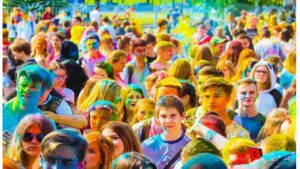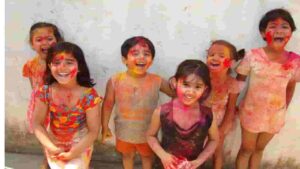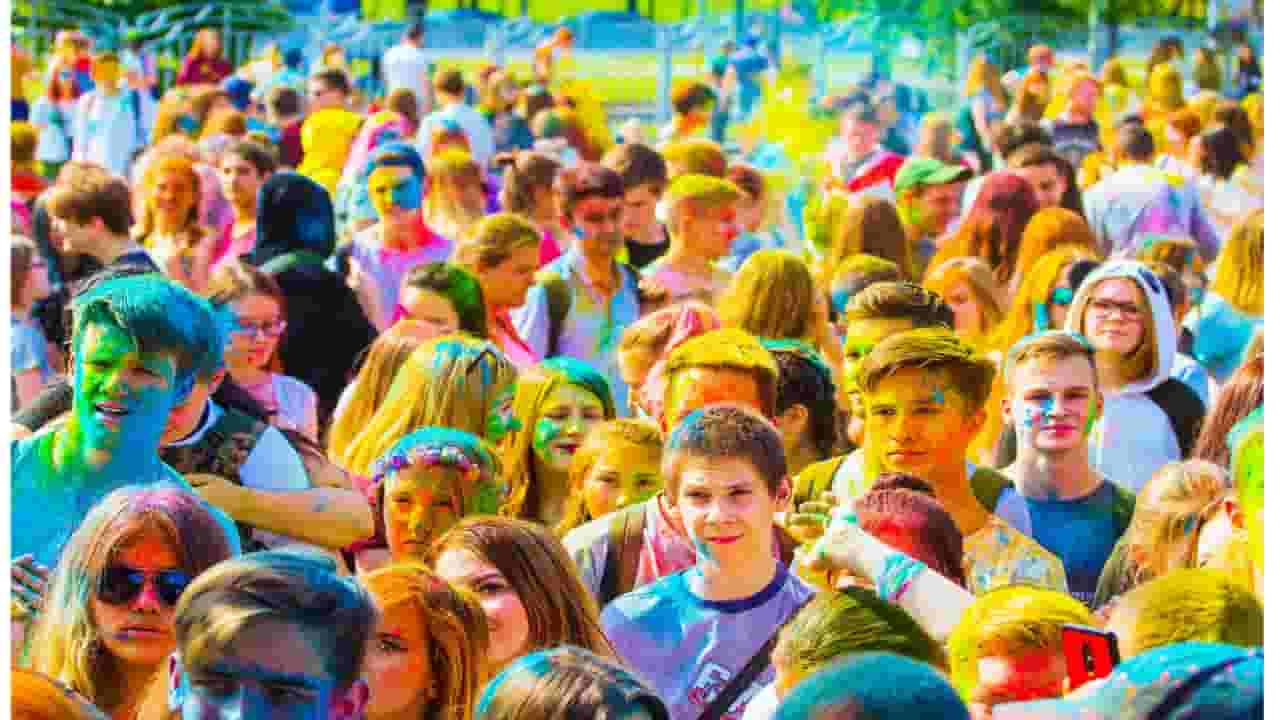Holi Festival is a Unique Ancient Attractive Festival of Hindus
Holi Festival is a Unique Ancient Attractive Festival of Hindus
Holi festival is a unique ancient festival of Hindus
Holi Festival Triumph
holi festival:
Holi Festival: What is Holi?
Holi Festival: Holi is a Hindu festival that is celebrated in India and other parts of the world by people of the Hindu faith. It is also known as the “Festival of Colors” or the “Festival of Love” and usually falls in late February or early March, according to the Hindu lunar calendar.
Holi Festival is a celebration of the arrival of spring and the victory of good over evil. The origins of the festival can be traced back to ancient Hindu mythology, where it is believed that a powerful demon king named Hiranyakashipu wanted to be immortal and was blessed with the power of immortality.
However, his son Prahlad, a devotee of Lord Vishnu, refused to worship his father and continued to worship Lord Vishnu. This angered Hiranyakashipu, and he tried to kill Prahlad multiple times, but Lord Vishnu saved him every time. Finally, with the help of Lord Vishnu, Prahlad defeated his father, and thus, the victory of good over evil is celebrated during Holi.
During Holi, people play with coloured powder and water, sing and dance to traditional music, and enjoy traditional sweets and delicacies. The holi festival promotes unity, forgiveness, and social harmony, where people forget their differences and come together to celebrate as one.

Overall, Holi Festival is a vibrant and joyful festival that celebrates the arrival of spring and promotes the values of love, togetherness, and unity.
Holi Festival: Holi 2023
In 2023, Holi is expected to be celebrated on Wednesday, March 8th. This date may vary slightly depending on the lunar calendar and the sighting of the moon.
Preparations for Holi usually start a few days before the festival. People clean their houses and prepare traditional delicacies such as gujiya, mathri, and thandai. Many people also buy coloured powder and water guns to play with during the festival.
On the day of Holi, people gather with their friends and family and play with coloured powder and water. They sing and dance to traditional music and enjoy holi festive foods and drinks. The festival promotes social harmony and encourages people to forget their differences and come together as one.
It is important to note that due to the ongoing COVID-19 pandemic, the celebrations may be affected. It is advisable to follow the guidelines and safety measures issued by local authorities and health experts to ensure a safe and enjoyable celebration.
Holi Festival Triumph:
It is celebrated with great enthusiasm and joy by people of all ages and backgrounds.
Holi Festival: History and Significance of Holi

holi festival is said to have originated from the legend of Holika and Prahlad. According to the legend, Hiranyakashipu, a demon king, wanted everyone in his kingdom to worship him instead of the gods.
The demon king ordered his sister, Holika, who was immune to fire, to enter a blazing fire with Prahlad in her lap. However, Holika was burnt to ashes, and Prahlad was saved by Lord Vishnu. This is why Holi is also known as the “Festival of Bonfire,” as it is celebrated by lighting a bonfire to symbolize the destruction of evil.
Another significant aspect of Holi is the use of colours. It is said that Lord Krishna, a Hindu deity, loved to play with colours and would throw coloured water and powders at his friends and lovers. This tradition has been carried on and is now a hallmark of the festival.
Celebrations of Holi
Holi is a two-day festival that usually falls in late February or early March. The first day is known as Holika Dahan or Chhoti Holi, where people light bonfires to symbolize the destruction of evil. The second day is known as Rangwali Holi or Dhulandi, where people play with colours and drench each other with coloured water, powders, and flowers. The festival is also celebrated with music, dancing, and feasting on traditional Indian delicacies.
Holi is not only celebrated by Hindus but is also embraced by people of other religions and nationalities. It has become a symbol of unity and harmony, as people from all walks of life come together to celebrate the triumph of good over evil and the arrival of spring.
Holi Festival: Precautions and Safety during Holi
While Holi is a fun-filled and joyous festival, it is essential to take precautions to ensure everyone’s safety. The use of chemical colours can cause skin allergies and eye irritation, so it is best to use natural colours made from flowers and herbs. It is also crucial to protect your eyes, ears, and hair by wearing glasses, earplugs, and a cap or scarf.
Holi is not just about playing with colours and having fun, but it also has social and cultural significance. The festival promotes the values of forgiveness, unity, and equality. On this day, people forget their differences and come together to celebrate as one. It is a time to mend broken relationships, forgive those who have wronged us, and start anew.
In addition to playing with colours, people also exchange sweets and traditional delicacies with their friends, family, and neighbours. Some of the popular dishes served during Holi include gujiya, mathri, dahi bhalla, and thandai. These dishes are prepared using traditional recipes and are an essential part of the Holi celebrations.
Holi is also celebrated by many communities outside of India, such as Nepal, Pakistan, and Sri Lanka. In recent years, Holi has gained popularity in other parts of the world, including the United States, Canada, and Europe. Many non-profit organizations and community groups organize Holi events to promote cultural diversity and awareness.
Despite its significance, Holi has also faced criticism for the use of chemical colours, which can be harmful to the environment and human health. In recent years, there has been a growing movement to promote eco-friendly and organic Holi celebrations. People are encouraged to use natural colours made from flowers and herbs and to avoid the use of plastic bags and water balloons.

One of the unique features of Holi is the use of music and dance. People dance to traditional folk songs and Bollywood music, creating a vibrant and energetic atmosphere. The most popular Holi song is “Rang Barse,” sung by Amitabh Bachchan in the 1981 Bollywood movie “Silsila.” The song has become an anthem for Holi celebrations and is played at almost every Holi party.
Holi also provides an opportunity for people to showcase their creativity and artistic skills. Many people make their natural colours using flowers, spices, and other natural ingredients. Some even create intricate patterns and designs using coloured powder.
Another important aspect of Holi is the community spirit it promotes. The festival brings people together and encourages them to share their joy and happiness with others. Many communities organize Holi events and invite people from different backgrounds to come and join in the celebrations. This helps to build strong bonds between people and promotes social harmony and unity.
In recent years, Holi has also become a platform for promoting social causes and raising awareness about important issues. Many organizations use Holi as an opportunity to spread messages about environmental conservation, gender equality, and social justice. This has helped to give a new meaning to the festival and has made it more relevant to the modern world.
Holi Festival: Holi date
The date of Holi varies every year as it is based on the Hindu lunar calendar. However, generally, it falls in late February or early March in the Gregorian calendar.
In 2022, Holi was celebrated on Monday, March 14th.
In 2023, Holi is expected to be celebrated on Wednesday, March 8th.
It is important to note that the dates of Holi may vary based on different regions and communities in India and other parts of the world. The exact date of Holi is usually announced by local authorities and religious leaders closer to the festival.
Holi Celebrations Vibrant Colors
Holi Festival: Holiday celebrations
Holi is a vibrant and colourful festival celebrated in India and some other countries around the world. The festival is usually celebrated in late February or early March, depending on the full moon day of the Hindu calendar.
The celebrations of Holi typically start on the night before the main day with a bonfire, known as Holika Dahan or Chhoti Holi. People gather around the bonfire to sing and dance, and to commemorate the victory of good over evil. They also perform religious rituals and burn the effigies of the demon Holika, who is associated with the legend of the festival.
The main day of Holi is known as Rangwali Holi, Dhulandi or Phagwah. It is a day of playing with colours, singing, dancing, and feasting. They throw coloured water balloons and use water guns to drench each other in vibrant hues.
The celebration of Holi also includes traditional sweets and savoury delicacies, such as gujiya, mathri, and thandai. People also exchange greetings, gifts, and sweets with friends, family, and neighbours.
It is a time when people forget their differences and come together to celebrate life and the beauty of diversity.




